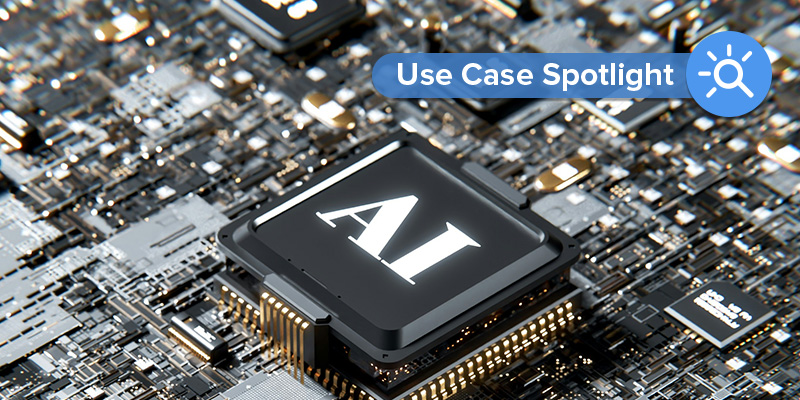Summary
According to Merriam-Webster, artificial intelligence (AI) is “a branch of computer science dealing with the simulation of intelligent behavior in computers” and “the capability of a machine to imitate intelligent human behavior.”[1] AI also encompasses machine learning, computer vision, and many other technologies. (For more detail on these technologies, check out Artificial Intelligence, a Technology Focus article.)
But what can AI do for airport operators? What are some of the challenges it presents? Airport operators saw the prominence and capabilities of AI skyrocket within the last year, and they want answers to these questions. The ability of AI to learn from data and make autonomous decisions opens doors for enhancing efficiency, security, and passenger experience. Yet AI is not without pitfalls—it can make mistakes and harbor biases that could impact performance and outcomes. For instance, misidentification of passengers or baggage by AI systems can lead to flight delays or cancellations.
This article is the second of a two-part series, providing a summary of the challenges that airport operators should consider as they plan to incorporate AI into their operations. Check out Part I for a walkthrough of many opportunities for using AI at airports.
Challenges
Airport operators need to keep a close eye on several challenges associated with the adoption and use of AI solutions, including privacy or data breaches, insider threats, malicious use of AI, implementation barriers, and AI failures.
Privacy or Data Breaches
AI technologies often have access to large amounts of data, including passenger information, flight schedules, and security camera feeds. If not properly secured, these technologies can become targets for cybercriminals seeking unauthorized access to sensitive data, potentially leading to privacy or data breaches. Airports need to be very careful with the internal information connected to these AI solutions, to ensure that no information gets out that may hurt the competitive or proprietary nature of their products. Airport operators likewise need to be sensitive to ethical considerations regarding the use of AI in security and surveillance to prevent potential misuse or invasion of privacy.
Insider Threats
Users with authorized access to AI systems, such as airport staff or contractors, could misuse their privileges to exploit vulnerabilities, steal data, or compromise system integrity. Insider threats pose significant risks, since individuals with insider knowledge may have access to critical systems and sensitive information.
Malicious Use of AI
Bad actors can use AI technologies to launch cyberattacks and disrupt operations. For example, AI-based malware could be designed to evade traditional security measures and cause significant disruptions to airport operations. These issues appear across all industries, and they will likely increase as advanced AI programs become more available. Airports will increasingly have to invest in threat detection and mitigation.
Implementation Barriers
As with all new technology, there will be barriers to implementing AI solutions. Airports are complex environments with many different stakeholder groups. Some examples of possible barriers facing a new AI solution implementation include computing or data requirements, data integration, privacy concerns and user consent, cost of early adoption, regulatory compliance, and job loss.
- Computing or data requirements: AI technologies need to perform calculations at high speeds, which requires appropriate hardware and data connections. Implementing AI infrastructure and training personnel can involve significant upfront costs and resource allocation.
- Data integration: For an AI solution to be used to the fullest, it will need access to all relevant data in the airport environment. Data access can be difficult for some airports to provide if they do not already have centralized data collection and storage. Additionally, most airlines do not like to share useful passenger and travel data with airports, which could limit the usefulness of some AI solutions.
- Privacy concerns and user consent: Any AI solution will need to be explained to the public and staff who are using it. Buy-in from all parties will be necessary.
- Cost of early adoption: Few complex AI solutions are currently in place at airports, which means an airport may have to make a major investment if they want to be first in line.
- Regulatory compliance: AI implementation at airports may be subject to various regulations and standards, which must be adhered to for legal and ethical reasons.
- Job loss: AI solutions could reduce airport jobs and hurt the local population; care should be taken when looking to automate any position or function.
AI Failures
Any AI solution can fail. AI models can be wrong, and they can create issues if a solution is not being monitored for accuracy while in use. Plan to always have someone available to verify the results of any AI activity. Airports also need to use caution when deciding which systems will have AI integration, at least until a solution is well-trialed and established.
Conclusion
AI usage is expanding quickly, and many airports are already participating with new security systems, autonomous vehicles, and passenger chat features, among other technologies. AI technologies will likely continue to grow more advanced as airports access higher data speeds and AI models are improved. Airport operators may want to monitor the industry for new deployments and advancements that could help their operations.
Other recommended reading on this site:
Artificial Intelligence (Technology Focus article)
References
[1] Artificial Intelligence, Merriam-Webster, Accessed May 6, 2020, https://www.merriam-webster.com/dictionary/artificial%20intelligence.
Header photo by Igor Omilaev on Unsplash, modified by Barich Inc.




